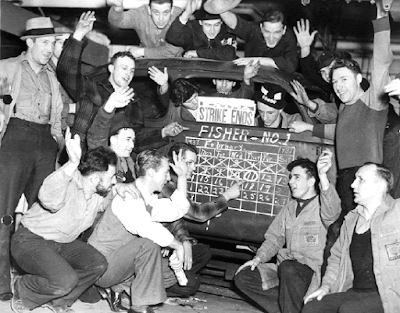Eighty years ago today the Flint Sit-Down Strike of 1937, the great heroic event in the unionization of the American auto industry, broke out. Previous attempts to organize by AFL craft unions and by the Industrial Workers of the World (IWW) had failed to make permanent inroads. The new United Auto Workers (UAW), an industrial union organized on lines similar the IWW and backed by John L. Lewis’s Congress of Industrial Organizations (CIO), had built scattered locals but had yet made no real headway in organizing the industry. Many thought the new union would fail.
The union decided to target General Motors for a major organizing drive by striking its two Fisher Body plants in Cleveland, Ohio and Flint, Michigan. By cutting off the supply of auto bodies, they could quickly shut down all GM production. Besides, the union had its strongest support at Fisher.
When the company got wind of plans to strike after New Year’s 1937, it started stripping essential stamping dies from the Flint plant to be sent to Cleveland. On December 30 local leaders at the Flint #1 plant called a hasty lunch-hour meeting and decided to launch a sit-down strike, occupying the plant and preventing the dies from being moved. The IWW had pioneered the sit-down strike at Briggs Auto and Murray Body in 1933, so the workers were aware of the tactic.
Workers set up cots, elected a “mayor” and council to run things, and got support from wives and family members who passed food through the plant windows. The union governing committee ignored repeated injunctions to end the strike and repelled an attempt by police to re-take the factory by force on January 11 by turning fire hoses on them. The strike spread to Chevrolet #4 and was attracting national attention.
Newly inaugurated Michigan Governor Frank Murphy, a New Deal Democrat elected with strong labor support, called up the National Guard not to attack the strikers, but to defend them from scabs and goon squads being organized by the company.
As production at all facilities ground to a halt, the company was forced to enter negotiations with John L. Lewis speaking for the UAW since the company refused to be in the same room with UAW leaders. On February 11 the company signed a one-page agreement recognizing the UAW as the bargaining agent of its members for the next six months.
 |
| Celebrating victory after almost a month and a half of occupying the plant. |
On the strength of this victory the UAW signed up more than 100,000 more GM workers and enforced conditions by local grievance walkouts across the country. Eventually other automakers, including highly resistant Ford, also recognized the union.



No comments:
Post a Comment